How a Man may Defend Himself against every Form of Attack
By E.W. Barton-Wright
(Originally published in Pearson's Magazine, March edition, 1899)


BEFORE proceeding to give my readers any particulars and explanations of the art of self-defence, perhaps it will not be out of place to make a few introductory remarks as to the conception of self-defence as generally understood by other nations.
In foreign countries people never fight for amusement or diversion, as is often the case in England and the United States. Bearing this fact in mind, it will be more easy to understand that when foreigners fall out and fight, they recognise one goal only, and that is to overcome and defeat their adversaries, and any means is considered justifiable and is resorted to, to attain this end.
Of course, what constitutes honour in this sense is entirely a matter of early training and education. In this country we are brought up with the idea that there is no more honourable way of settling a dispute than resorting to Nature's weapons, the fists, and to scorn taking advantage of another man when he is down.
A foreigner, however, will not hesitate to use a chair, or a beer bottle, or a knife, or anything that comes handy, and if no weapon is available the chances are he would employ what we should consider are underhanded means. It is to meet eventualities of this kind, where a person is confronted suddenly in an unexpected way, that I have introduced a new style of self-defence, which can be very terrible in the hands of a quick and confident exponent. One of its greatest advantages is that the exponent need not necessarily be a strong man, or in training, or even a specially active man in order to paralyse a very formidable opponent, and it is equally applicable to a man who attacks you with a knife, or a stick, or against a boxer; in fact, it can be considered a class of self-defence designed to meet every possible kind of attack, whether armed or otherwise.
Of course it is not possible in a short article like this to do complete justice to the subject, or to explain all the manifold ways of encountering or delivering attacks, but the principle may be briefly summed up as follows: (1) to disturb the equilibrium of your assailant; (2) to surprise him before he has time to regain his balance and use his strength; (3) if necessary to subject the joints of any part of his body, whether neck, shoulder, elbow, wrist, back, knee, ankle, etc. to strain which they are anatomically and mechanically unable to resist. The explanations which follow, with the assistance of the photographs reproduced, will show what a weak man with a knowledge of leverage and balance can do against a stronger man than himself who has not the same knowledge.
Some of the feats may, perhaps, seem difficult, but if the instructions are carefully followed and the positions in the photographs clearly understood, I feel sure that steady practice will make them quite easy of performance.
You may say that it will be impossible to get the assailant into the positions shown, but it must be borne in mind that you are not seeking a quarrel or attacking, but simply defending yourself.
It is quite unnecessary to try and get your opponent into any particular position, as this system embraces every possible eventuality and your defence and counter-attack must be based entirely upon the actions of your opponent. The illustrations only show how to defend yourself against some of the more common forms of attack.
Finally, I cannot emphasize too strongly the fact that these feats can be thoroughly understood without proceeding to extremes. If a policeman is holding a prisoner in a certain position, it is not necessary to break the man's arm to show his power, though he could do so if he wished. So in these methods of self-defence when your opponent is once at your mercy he will cry ""Hold!" long before you could seriously injure him.
Objection may be taken to my stating that a man who attacks you with a knife or other weapon can be easily disarmed, while I do not say how this is to be done in any of the illustrated explanations on the following pages. At the request of the editor, who thought it inadvisable that such great publicity should be given to these feats, I have purposely omitted them.
If the readers of PEARSON'S MAGAZINE desire to be further initiated into the ways of meeting every conceivable contingency, I would ask them to make direct application to me.
There is, however, one simple and effective way of meeting an attack with a knife that I will explain. We will suppose that you have to pass through a locality late at night where there is a likelihood of such an attack, and you do not wish to run the risk of bringing yourself within the law by relying upon a revolver.


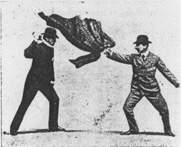
Carry your overcoat upon your shoulders without passing your arms through the sleeves, in the style of a military cloak, with your right hand ready upon your left shoulder to use your coat in the way explained below, should the necessity arise. Be careful always to walk in the middle of the road. Directly your assailant attacks, face him and wait until he is within a distance of two or three yards. Then envelop his head and arms by throwing your coat at him, with a sweeping, circular motion of the arm. This will obscure his view momentarily, but not your own, and will give you plenty of time to deliver your attack, which should take the form of a right-handed knock-out blow in the pit of the stomach.
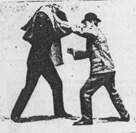


Or while he is still enveloped in the folds of your coat, slip round behind him, seize him by the right ankle, and push him under the shoulder blade with your left hand. You will thus throw him very violently upon his face, and in his endeavour to break his fall and protect his face he will put out his hands, and in doing so, involuntarily drop his weapon. He will then be disarmed and in a position where you can break his leg immediately if you so like, or if you do not wish to proceed to such extremes, you can hold him down in the position shown in No. 6 until the police arrive. This is only one of the many ways I have of meeting such a contingency. (E.N. 1)
I may state that I have repeatedly been attacked during a long residence in Portugal by men with knife or six-foot quarter-staff, and have in all cases succeeded in disabling my adversary without being hurt myself, although I had not even a stick in my hand with which to defend myself.
To give you some idea of the scope of this method of self-defence I may state that it comprises about three hundred different throws, attacks, counters and tricks based upon balance and leverage. A selection of these will be published in the pages of this magazine, and later on I shall hope to bring them all together in book form.
No. 1 - A Good Way of Conducting a Person out of the Room
Here is an excellent method of forcing an undesirable person out of your room. It will be found particularly useful in case he should try to strike you.
You seize the opponent by the left wrist or left hand with your left hand, raising your right hand to guard your face from a blow. Pull him towards you with your left arm, without altering the position of your legs. Then turn upon your heels, and pass your right arm over his left upper arm.
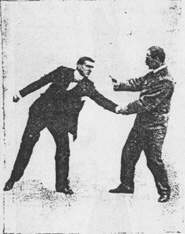

You then pass your right hand under his left fore-arm, and lock his arm by seizing your own wrist. Finally, by straightening both your arms, you are able to exert such leverage, and to throw such strain upon his elbow, that you could break it if he attempted to resist. Moreover, if the leverage be exerted in the proper way, it will also be found that it is quite impossible for your opponent to hit you or to retaliate in any way.
In case anyone should fight shy of making practical use of this trick, it may be added that the person to be experimented upon, if he resists, would feel such pain that he would be compelled to submit meekly long before any serious injury could be done to him.
It will not be necessary to impress upon the reader the importance of knowing how any undesirable visitor my be promptly ejected from a room. Thousands of cases have occurred in which a knowledge of this method would have been of inestimable service. No-one could resist the treatment that I have suggested, as the reader will be able to understand for himself by testing it on his friends.
No. 2 - How to Overthrow an Assailant who Attempts to Strike you in the Face
This is a most useful feat, and the student of the new art of self-defence will do well to understand it thoroughly. We are assuming that your assailant begins his attack by attempting to strike you in the face.
The first thing to be done is the most difficult, but the art of doing it may be soon acquired, and the rst will follow easily. We suppose that your assailant strikes at you with his right hand. You must guard yourself by raising your left arm and receive the blow on your fore-arm. Then, slip your hand up your assailant's arm and grasp him by the wrist.
A quick, clean movement of the hand is all that is required, but you must make sure to grasp your adversary at the first attempt. Then you step to the side with your left foot, strike your assailant behind the ear with your right fist, and continue the movement by placing your right leg behind his right leg.
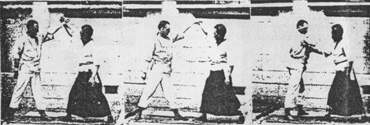
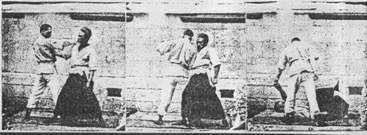
Retaining your hold of his right wrist with your left hand, pull him towards you. Then press upon the upper part of his arm with your right fore-arm and, leaning over his right arm with your body, you can throw him to the ground without further trouble.
Of course, the same tactics are applicable if a man strikes (at) you with his left fist. In this case you guard by receiving the blow with your right fore-arm, slipping your hand up his arm until you seize his wrist, and then proceeding with the trick as already described.
It will be noticed that in the series of photographs on this and the subsequent pages, my vis-à-vis is dressed in Japanese costume. In fact, he is a prominent Japanese wrestler, and these photographs were actually taken in Japan, the majority of these feats, I may explain, being elaborated from the Japanese style of wrestling. (E.N. 2)
No. 3 - How to Overthrow an Assailant who Attacks you from Behind and Pinions your Arms
Supposing you are suddenly and unexpectedly attacked from behind in some lonely spot, finding a strong pair or arms encircling your body, so that your own arms are pinioned to your sides. Your position might appear at first sight as utterly helpless - you might suppose that unless you were able to free yourself by struggling and kicking, nothing could save you from being thrown upon your back.
By carrying out the following instructions, however, you will find that it is your assailant and not yourself who will be lying on his back before many seconds have passed. This feat is a particularly neat performance, and in every way satisfactory in case of the emergency I have described.
First when finding your arms pinioned to your sides, bend forward and force your elbows outwards and upwards as in the second illustration. Make yourself shorter by bending your knees, so as to cause your attacker's hold to slip over your shoulders.

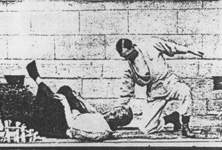
Then, free your arms. There will probably be no difficulty in executing this movement. However, should your opponent clasp you so firmly that you still find your arms pinioned, jerk your head backwards, striking him in the face. Then, having by this manoeuvre effectively loosened his hold, you seize his right wrist with your left hand, and the shoulder of his coat with your right hand, dropping at the same time upon your right knee, and pulling him over your right shoulder, accompanying the movement with a right to left swing of the body. You thus deposit your adversary with a heavy thud upon his back before you.
No. 4 - How to Overcome an Assailant who Seizes you by the Waistbelt, or attempts to Grasp the Pocket of your Coat.
To lay upon his back, in the space of a few seconds, an assailant who seizes you by the waist, five simple movements are necessary. First, you seize his right wrist with your left hand; secondly, you take a step to the side with your right foot, next you strike him a backhander with your right hand. Fourthly, you place your right foot behind his right knee, and lastly you press on his right shoulder, with the result that he will be thrown ignominiously on his back.


Here is another way of defending yourself, and overthrowing an assailant who attempts to seize you by the pocket of the coat. We will suppose that he makes the attack with his right hand. With your left hand firmly grasp his right wrist. Then seize his throat with your right hand, forcing your thumb into his tonsil. This will cause intense pain, and he will bend his head and body backwards in order to avoid it. In this position he is standing off his balance and you take this opportunity of placing your right foot behind his right knee, and then proceeding to throw him as before.
No. 5 - How to Disengage yourself and to Overthrow an Assailant, who Seizes you by the Lappet of your Coat with his Right Hand
Your assailant seizes you with his right hand, perhaps intending to snatch your watch with his left. You desire not only to frustrate his design, but to lay him upon his back with as little trouble as possible in order that he shall not escape you, and may be duly handed over to the police. You will find the following method will meet your requirements: -
Directly he seizes you grasp his right wrist with your left hand, the outside of your hand being upward or on the top, and your thumb underneath his wrist.
Then take a step sideways with your left foot and slightly forwards, so that with another step you can place your right foot well behind his right leg. As soon as you have stepped on one side, turn yourself half sideways and strike him with right fist behind the ear.
(In ordinary practice in this feat, as in many others which I describe, it will only be necessary to pretend to deliver this blow; the object of the blow being not so much to injure your assailant as to make him throw back his head in order to avoid the blow, by which means he will involuntarily lose his balance.)
Then when he is off his balance, but not before, follow up the motion by placing your right leg quickly behind his right leg. Then bear down on the upper part of his arm, commencing at the shoulder, and ending at the elbow, with the outside part of your fore-arm as illustrated in the photograph on this page.
While you are doing this, you retain a firm hold of his right wrist with your left hand. Pulling him towards you with your left hand, and leaning over his right arm with your body, you cause him to lose his balance and by this means he will be easily thrown upon his back.


This series of movements must, of course, be performed as quickly and as neatly as possible. The effect will be very disastrous to your assailant, who will be completely at your mercy.
(In our next issue we hope to give a further selection of these remarkable feats. Ed. P.M.)
NOTE -
Mr. E. W. Barton-Wright, the author of this article and of its companion to be published next month, has just introduced into this country a method of self-defence which would seem to render anyone acquainted with it practically impregnable against all forms of attack, however dangerous and unexpected they may be.
It is possible, however, that after a consideration of the explanations which follow, many persons will exclaim, "this is all very well on paper, but in practice it will probably be otherwise." We must confess that when Mr. Barton-Wright first came into this office with his credentials and claims (a short, good-looking man with no indications of unusual strength) we ourselves were somewhat sceptical, but a few practical tests soon showed that we were in grievous error. Others, too, have scoffed at first - professional strong-men, gymnasts and athletes generally - but not one of these has met Mr. Barton-Wright and put him to the test who has not in the end been bound to admit that his system is irresistible.
His extraordinary resource in meeting every imaginable kind of attack was exemplified in a most remarkable manner at a performance which we had the opportunity of witnessing a few weeks ago. On this occasion, Mr. Chipchase, the amateur champion of the Cumberland and Westmoreland style of wrestling, made many attempts to overcome Mr. Barton-Wright's defence, all of which were unsuccessful. By way of experiment, Mr. Chipchase was allowed to seize him by one leg to prove whether, with this advantage, he could tip him over backwards. But, incredible as it may seem, Mr. Barton-Wright, apparently without the slightest exertion, threw his opponent at once and disengaged himself.
Then he stood with both feet together and allowed Mr. Chipchase to seize him by both his ankles. In spite, however, of this handicap, Mr. Barton-Wright succeeded in extricating himself, and throwing his opponent instantaneously. He then allowed himself to be seized from behind, with his arms pinioned to his side, but again he threw his opponent at once upon his back.
Perhaps his most remarkable feat was to allow the amateur champion, standing with his back to him, to reach over his shoulders and seize him by the neck and head, and with this hold throw him right over his head. But whilst in the air Mr. Barton-Wright grasped Mr. Chipchase in some way, which, owing to the speed at which it was performed it was impossible for the eye to follow, and although apparently thrown himself, he had, by the time he reached the ground, thrown his opponent and was kneeling over him. Many other feats just as extraordinary and just as conclusive, were also performed on this occasion, apparently without an effort.
Extraordinary interest has been evinced in this new art of self-defence by the privileged few who have already had the opportunity of forming an opinion as to its efficacy. Colonel G.W. Fox, for instance, the Assistant Adjutant-General of the York district and ex-Inspector General of Army Gymnasia, writes; "I have no hesitation in pronouncing Mr. Barton-Wright's system as absolutely sound in theory, exceedingly practical and very scientific. I was much impressed with the extremely easy and graceful way in which he seemed to disturb the balance of his opponent and render him helpless. And although Mr. Barton-Wright repeatedly allowed his opponent to choose his own hold and take him at the greatest possible disadvantage, he never seemed to be at a loss what to do, and how to throw his opponent instantaneously. I am quite certain that if our police were to learn some of his throws and grips, they could cope much more successfully with every kind of resistance."
Mr. Chipchase's opinion as an expert may not be uninteresting. He says; "In spite of my being a much heavier man than Mr. Barton-Wright, his system of defence and retaliation is so much more scientific than my style, that, when practicing with him, however great may be my determination to remain firm on my legs and to keep my balance, my efforts are invariably frustrated and I am ignominiously thrown. Mere strength has no chance of withstanding the science of this new art."
Mr. Chipchase also recommends this new system of self-defence to the police, and with this recommendation we cordially agree; in fact, we are, at the present moment, taking steps to introduce Mr. Barton-Wright to the Chief Commissioner of Police.
Notes:
EN1 - although the majority of the self-defence techniques described by Barton-Wright are obviously derived from jujitsu, this manoeuvre closely resembles a technique adapted by contemporary maitres de savate from the Apache repertoire of street-fighting tricks. "Les Apaches" were typically young pimps, gangsters and prostitutes who were especially associated with the Montmartre district of Paris.
EN2 - Recent research suggests that the Japanese gentleman partnering Barton-Wright may have been Yoshinori "Yazo" Eguchi, a senior teacher of Kyushin-ryu jujutsu.